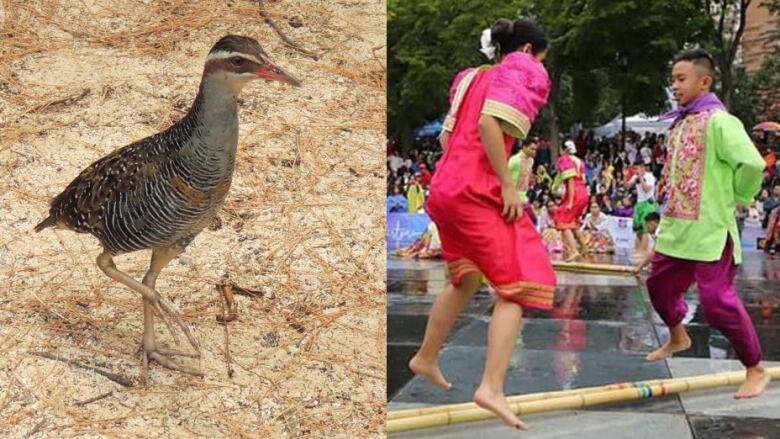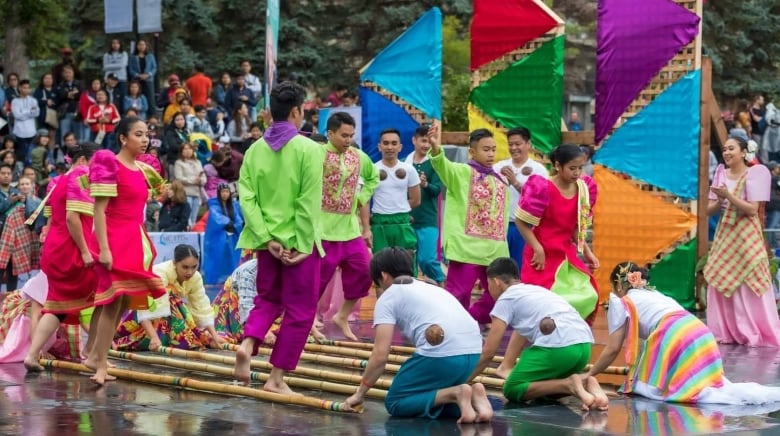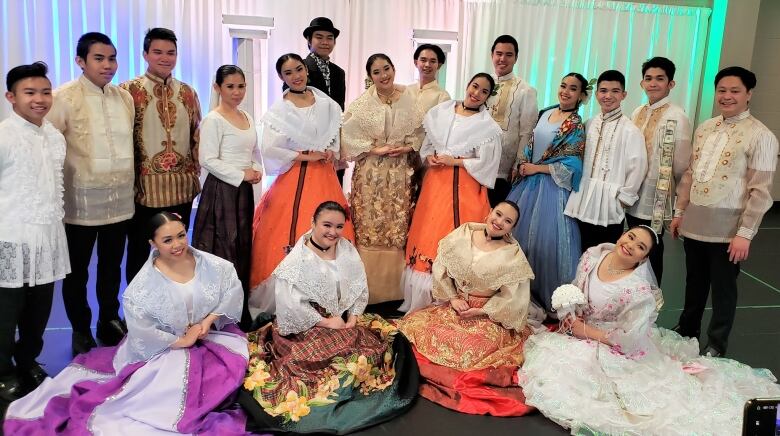Fancy footwork: Philippine folk dancing mimics movement of birds
Q+A: Calgary's Binhi ng Lahi troupe introduces us to Filipino folk dancing

There's an old Philippine folk dance calledtinikling. It's named after a sneaky, chicken-sized bird that's very good at stealing rice and evading bamboo traps.
Barefoot dancers skip over and between long bamboo sticks which are skimmed along the floor they're separated and then brought together lightning quick to the rhythm of music. Miss a beat and you'll stub a toe. Or break an ankle.
"I was on crutches for two weeks because I stepped on the bamboo wrong," said Vida Valerie Vispo, a senior performer with the Binhi ng Lahi Philippine Dance Troupe in Calgary.
Just one of her more "memorable" dance accidents, she says.

Filipino folk dancing has a long and venerable history. Like most cultural traditions, it's rooted in community.
While Vispo and her fellow dancers can't perform tinikling or other dance routines for live audiences right now, the Binhi ng Lahi troupe is finding other ways to stay connected to one another and the broader Calgary community.
It's holding virtual rehearsals, open to anyone, and offering monthly online lectures about Philippine arts and culture called Sining Filipinas.

As part of our ongoing CBC Calgary Filipino pop-up bureau, we wanted to learn more about the richhistory of Philippine folk dancing.So we invited Vida Valerie Vispo and two other foundingmembers of Binhi ng Lahiaround our virtualtable: program director Noel Lloren andartistic directorAllan Lomboy.
You can hear the conversation or read through an abbreviated version below. Both have been edited for clarity and length.
Danielle Nerman: Allan, you design all the costumes?
Allan Lomboy:I actually learned all those skills from my dance company (in the Philippines).What we do there is not just the dance. We actually learn how to make our own props, our own costumes andrepair them. I'm (also) just very lucky that my mom is a seamstress, sowe are partners together. And when we applied to come here, I told Noel, 'You know what?Someday we will startour own dance company in Canada. We're not just going to go there to work and to start our new life.' I still wanted to continue my passion and dancing.
DN: So your dream came true. You're doing it! The (folk dance)troupeitself, tell me about the dancers?
Noel Lloran: So I think the youngest that we have is eight and the oldest that we have is around 45. Most of them immigratedfrom the Philippines not too long ago. But we have a big chunk of members who, you know, were born and raised here and who don'thave any idea of what a Barong Tagalog is (traditional formal wear for men) or they're missing a big piece of their identity, I think, in terms of cultureand tradition.
DN: How much has your (dance) group grownsince you started?
Noel Lloran: So we started like, you know, me, Allan, Vidaand her siblings, and that was about it. So I would sayless than 10. But right now, between members and volunteers and parents, we're about 45altogether.
- WATCH | See Binhi ng Lahi dancers in action in the video above
DN: Vida, I'd like you to talk a little bit aboutthe dances, because it seems that there are,maybe, hundreds of different dances because of the hundreds of islands (in the Philippines)?
Vida Valerie Vispo: Yeah, that's completely right. So, like, the one I'm wearing right now because we were colonized by the Spanish for about 300 years so that's where this dance (Maria Clara) comes from. There's another one which is the Muslim dance, more in the southern part of the Philippines. So that one has a lot of, like, prince and princess kind of thing.

Allan Lomboy: And the uyaoy from the Ifugao tribes who built the famous rice terraces. Those tribes arelikethe farmers of the north. So they dance when they have a bountiful harvest, during weddings and even, death, like they dance. They want to make sure that their loved ones, the spirit of their loved ones, goes to, you know, to a better place
DN: If anyone wants to join your group, is there auditions? Are there fees? Tell me a little bit about that.
Noel Lloren: So we are 100 per cent volunteers. We are just so lucky that we were funded by the city, through Calgary Arts Development (CADA). And in terms of membership, we don't charge any fees. So if you guys wanted to, you know, experience Filipino folk dance then our doors are open. And based on our experience, everything can be learned. So it doesn't matter how old you are, as long as you have the passion of learning it. I think you should be able to perform a dance or two after a few sessions.














_(720p).jpg)


 OFFICIAL HD MUSIC VIDEO.jpg)
.jpg)



























































































